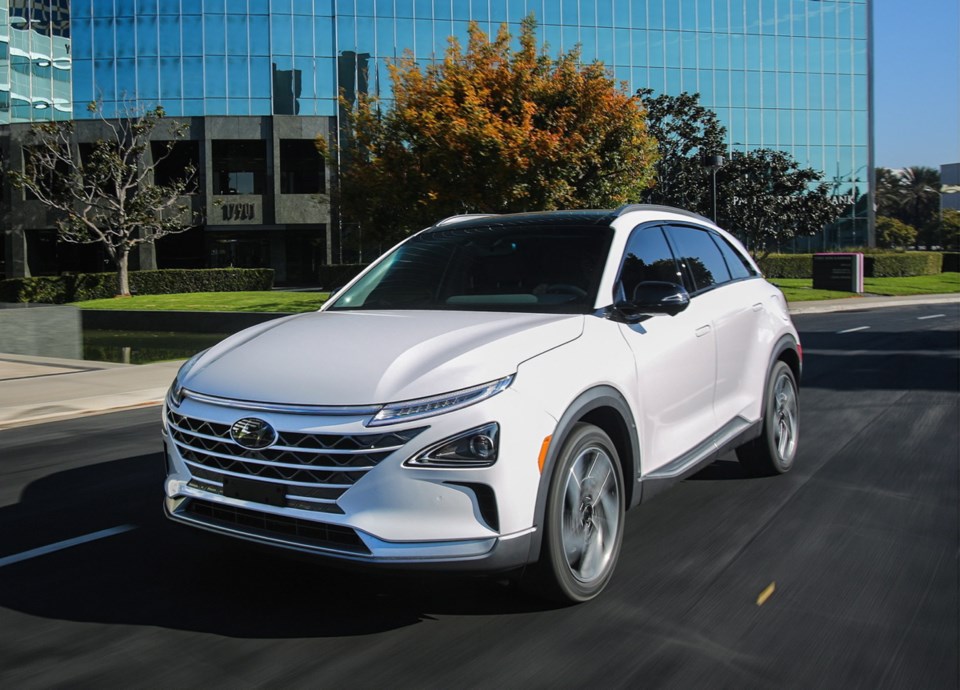Fuel-cell vehicle manufacturers are targeting British Columbia as a key market for the rollout of their vehicles, such as the 2019 Hyundai Nexo.
While car companies are ramping up to deliver plug-in electric vehicles (commonly referred to as battery electric vehicles, or BEVs), two are already touting an alternative, the fuel-cell electric vehicle, or FCEV.
In a FCEV, electricity is produced in an electrochemical process when hydrogen and oxygen atoms are combined in a fuel-cell stack. The only exhaust emission is water vapour.
The Nexo, with a list price of $73,000, joins the Toyota Mirai as the only commercially available fuel-cell vehicles in Canada.
Why hydrogen? Advocates believe that hydrogen makes sense in terms of onboard packaging and refuelling logistics. Unlike BEVs, which need a large battery pack to store their energy, a FCEV stores its energy in tanks, much like a gasoline-powered car.
The Achilles heel of current electric vehicles has been their relatively short range and the long charging times for the batteries — up to nine hours to fill a 60-kWh battery for 380 kilometres of driving in a Chevrolet Bolt, for example.
The Nexo can be filled far more quickly, in about five minutes, akin to a gasoline-powered vehicle, with a range of up to 570 kilometres.
There is a side benefit for Canadians — FCEVs suffer less efficiency loss in cold weather compared with electric vehicles. The fuel-cell stack can generate enough heat to warm the cabin without resistance heating (mandatory in EVs) in many cases.
The hydrogen gas is stored in reinforced tanks — the Nexo has three.
The fuel stack produces electricity to charge a 1.6-kWh lithium-ion polymer battery. That in turn powers an electric motor.
The Nexo carries an electric motor that produces 161 horsepower and 291 pound-feet of torque, delivered to the front wheels via a single-speed transmission.
It drives like any electric vehicle, with power available instantaneously and quietly. A pair of steering-wheel paddles lets you select between four regenerative cycles, allowing you to drive, with practice and planning, almost entirely without touching the brakes. (Note that you can do this with other BEVs as well.)
But here is the chicken-and egg-scenario: The car industry wants to sell more vehicles, but the energy industry is hesitant to build a hydrogen-fuelling infrastructure until there is sufficient demand to justify the expense.
To date, there are only two hydrogen stations in the province, with plans to add four more by the end of 2020. (Don’t feel badly, as there are only 41 hydrogen-fueling stations in the whole U.S., the vast majority found in California.)
The lack of a suitable distribution infrastructure is telling, considering that Ballard Power Systems, based in Vancouver, is one of the early pioneers of fuel-cell technology use in transportation (you might remember the fleet of 20 Ballard-powered B.C. Transit buses used during the 2010 Winter Olympics).
The Nexo is actually the second fuel-cell vehicle I have driven from Hyundai.I briefly drove a Hyundai Tucson FCEV back in 2014. Based on the compact Tucson SUV, the manufacturer claimed it was the world’s first mass-produced hydrogen fuel-cell vehicle.
Both Hyundai and Toyota have been offering FCEVs in California, with the former entering the market in 2014 and the latter in 2015.
For all of its technological wizardry under the hood, the Nexo, which is about the same size as a Hyundai Santa Fe, looks fairly conventional on the outside, with an SUV body that is all the rage these days.
The interior, on the other hand, is certainly more avant-garde in look with a rectangular digital screen across half the upper dash for all vehicle information. A monochromatic silver centre console includes push buttons (and three rotary knobs) to control the climate, change gears, navigation and pull up information for the digital screen.
As with most EVs, the Nexo powertrain is so quiet that you only notice road and wind noise in the cabin.
It carries five passengers or, with the rear seats folded, 839 litres of cargo.
Although the Nexo is available for sale, don’t expect to see or drive one anytime soon, as there are no refuelling stations on Vancouver Island, let alone Victoria.
The fuel cell stack also degrades over time — at least 10 years or 160,000 kilometres, according to Hyundai — which is about par with the expected life of an internal-combustion engine.
Will you see more hydrogen-powered vehicles on the road? Not in the foreseeable future. The FCEV is where the EV market was about five years ago. The nascent technology shows great promise, but there are significant hurdles it must overcome before it sees widespread adoption.
THE SPEC SHEET
Type: Compact SUV, front engine, front-wheel drive
Fuel Cell Electric Vehicle: Fuel cell stack
Electric engine: 161 hp and 291 lb.-ft. of torque
Battery: Lithium-ion polymer, 1.6 kWh, 240 V
Transmission: Single speed
Dimensions (mm): Length, 4,670; width, 1,859; height, 1,631; wheelbase, 2,789
Curb weight (kg): 1,867
Price (base/as tested): $73,000/ $75,010 (includes $1,910 freight and PDI and $100 AC tax)
Options: Nil
Tires: 245/45 R19 on alloy wheels
Fuel type: Hydrogen
Fuel economy (Le/100km): 4.0 city/ 4.4 highway
Range (km): 570
Warranty: Five years/100,000 km new car and powertrain



